
M76 - Little Dumbbell Nebula
Messier 76 or M76 (also designated NGC 650/1) is a planetary nebula in the constellation Perseus. It has an apparent visual magnitude of 10.1 and its angular diameter is 2.7x1.8 arc-minutes. M76 lies at an estimated distance of 3400 light years. The Equinox 2000 coordinates are RA= 1h 42.4m, Dec= +51° 34´ which makes M76 best seen during the autumn. The Messier Autumn Star Chart shows the position of all Messier objects visible during that season. As one of the more famous objects in the Messier Catalog, it is commonly known as the Little Dumbbell Nebula.
The image above shows the uncropped view of M76 through the Takahashi E-180 Astrograph (North is to right). A 3x enlargement of this image appears to the right.
M76 was discovered by P. Méchain in 1780. It is one of only four planetary nebulae in the Messier Catalog (M27, M57, M76, and M97). One of the faintest Messier objects, the Little Dumbbell Nebula is also known as the Cork Nebula, Butterfly Nebula, and Barbell Nebula.The central star is a magnitude 16.6 white dwarf with a temperature of 60,000 K. The nebula itself is the cast-off shell of this dying star. According to Stoyan et al. (2010), the distance of this planetary nebula is 2550 light years and its diameter is 0.7 light years although there is some uncertainty in these values. Its age is not known.
For more information, see the Messier Catalog as well as specific entries for M76 in Wikipedia and SEDS.
Messier's Description of M76
October 21, 1780
`Nebula at the right foot of Andromeda, seen by M. Méchain on September 5, 1780, and he reports: "This nebula contains no star; it is small and faint". On the following October 21, M. Messier looked for it with his achromatic telescope, and it seemed to him that it was composed of nothing but small stars, containing nebulosity, and that the least light employed to illuminate the micrometer wires causes it disappear: its position was determined from the star Phi Andromedae, of fourth magnitude.' (diam. 2')
Technical Details
- Object: M76
- Other Names: NGC 650/1, Little Dumbbell Nebula
- Object Type: planetary nebula
- Object Data: Apparent Magnitude = 10.1, Angular Size = 2.7x1.8 arc-minutes
- Object Position (Equinox 2000): RA= 1h 42.4m, Dec= +51° 34´, Constellation = Perseus
- Date/Time: 2011 Oct 20 at 05:29 UTC
- Location: Bifrost Astronomical Observatory, Portal, AZ
- Mount: Astro-Physics 1200GTO
- Telescope: Takahashi Epsilon 180 Hyperbolic Astrograph
- Camera: Canon EOS 550D (Rebel T2i) (modified with a Baader UV/IR filter)
- Field of View: 1.70° x 2.56° at 1.7 arc-sec/pixel (web version: 10.0 arc-sec/pixel)
- Exposure: 4 x 300s, f/2.8, ISO 800
- File Name: M76-01w.jpg
- Processing (Adobe Camera Raw): Graduated Filter, Vignetting Correction, Noise Reduction, White Balance, Curves
- Processing (Photoshop CS5): Average Images, Curves, Noise Reduction
- Original Image Size: 3454 × 5179 pixels (17.9 MP); 11.5" x 17.3" @ 300 dpi
- Rights: Copyright 2011 by Fred Espenak. All Rights Reserved. See: Image Licensing.
